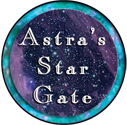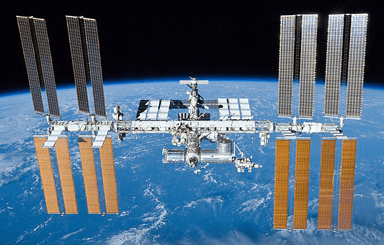On this page: US National Lab | Assembly Continues | New Solar Arrays | Commercialization | Nauka Module | Prichal Module |ISS Education | Axiom Space Missions to ISS
More ISS topics @ Astra's:
ISS Pages | Latest Mission | Life on ISS | Resupply Vehicles | International Partners | Commercial Crew
ISS: Building the Human Community in Space Exploration!
The last shuttle mission to the International Space Station was STS-135 or the ISS assembly flight ULF- 7. It was the last mission of the American Space Shuttle program and also the final assembly mission. ISS assembly was considered complete at that time.
- - International Space Station's 20th anniversary - -
The 1st human crew boarded ISS on November 2, 2000!
U.S. National Lab
The International Space Station was designated as the U.S. National Laboratory by Congress, to enable space research and development under the 2005 NASA Authorization Act. This allowed open access to the US Laboratory on ISS for commercial, academic, and government users. The National Laboratory can be used to conduct research in life sciences, physical sciences, technology development and remote sensing.

NASA issued Research Announcements for ISS Utilization in 2012 and 2020 asking for proposals for Exploration Technology Demonstrations and National Lab Utilization Enhancements. Proposals will be accepted until December 31, 2024!
An active commercial partner for the National Lab is Nanoracks who has supplied a lot of logistics and made many educational programs possible. Many educational programs have been sent to ISS.
Tomatosphere
Tomatosphere is a free program that uses the excitement of space exploration to teach the skills and processes of scientific experimentation and inquiry. The Seed Foundation and the International Space Station National Lab work together to send tomato seeds to the International Space Station (ISS) and bring them back to Earth for classroom use. Students receive 2 packets of seeds to grow in their classroom. One packet has been to space and the other has not. Tomatosphere is a "blind test" as teachers and students don't not know which packet has the "space" seeds and which packet has the control seeds until the germination process is complete and results have been submitted.
Tomatosphere is just one example of how the National Laboratory can be used for education. Educators in the U.S. and Canada can register for free to receive tomato seeds that flew on the Space Station. More than 3.3 million students have participated since Tomatosphere started in 2001.
Tomatosphere - from First the Seed Foundation
External links to National Lab pages
Space Station Assembly Continues
Even though the Space shuttle has stopped launching in 2011, that doesn't mean that ISS has not been growing! So here's what's new and what is happening today!
Bigelow Expandable Activity Module (BEAM)
BEAM is an experimental expandable space station module for testing the inflatable habitat concept. It was developed by Bigelow Aerospace under a NASA contract. Launched on SpaceX Falcon 9 Full Thrust, BEAM arrived at the ISS on April 10, 2016. It was a temporary module on the International Space Station (ISS) that was intended to last until 2020. The module's on-orbit performance had exceeded expectations, including resistance to micrometeors so it may remain on the station until 2028. BEAM is now being used for storage to free up space on the station.

This video from Bigelow is too cool not to share!
Bishop Airlock

Nanoracks' Bishop Airlock, was launched on SpaceX's 21st cargo resupply (CRS-31) mission. It was installed on Node 3 on December 21, 2020. The airlock is a passageway that allows projects, research, satellites, tools, and more to move in and out of the ISS. It can be operated in pressurized or unpressurized mode. Bishop Airlock is a commercially-owned and operated "door" that allows 5 times the payload volume to pass through than was previously available on the JEM Airlock on Kibō module developed by JAXA. It is the the first commercial airlock ever installed on a space station.
Bishop is named after the bishop chess piece that moves diagonally across the chessboard. Now astronauts will be able to open a hatch inside the station to store items in the airlock. When they are ready to be released and the inner hatch is sealed. The ISS robotic arm, Canadarm2 will be operated from NASA's mission control to remove the outer airlock and deploy the payloads. When the item is removed the outer airlock hatch will be reattached to the station. Customers will pay Nanoracks when they use the airlock.
Nanoracks has deployed small CubeSats into orbit from the ISS through the Nanoracks CubeSat Deployer via the airlock in the Japanese Kibō module. The expertise gained from launching those small satellites will be applied to the Bishop airlock.
Nanoracks has assisted educators and commercial organizations access to space by supplying research boxes (small racks) to contain scientific experiments and small satellites and integrating them into the station's hardware. Nanoracks partnered with Boeing who fabricated and installed the Airlock's Passive Common Berthing Mechanism (PCBM) that is used to connect many of the pressurized modules to the ISS. The PCBM hardware was manufactured at the Boeing facilities in Huntsville, AL. The shell of the Bishop Airlock was built by Thales Alenia Space who also built the Tranquility Node where the airlock was attached.
As Bishop Airlock is privately-funded service, it is helping NASA to achieve the agency's goal of providing services for commercial customers in low-Earth orbit market instead of just government agencies. NASA, ESA, and a Japanese robotics company, GITAI, are among the first users of the Bishop airlock.
- - Learn more about Nanoracks on Astra's Commercial Space Development page.
New Solar Arrays provide more Power
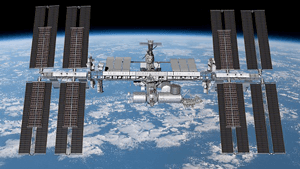
The SpectroLabs has developed an advanced solar power technology, their XTJ Prime solar cells that will be installed on the ISS. SpectroLabs is a Boeing company based in Sylmar, CA that produced the iROSA arrays. These solar arrays are some of the most powerful ever sent into space. They are the same solar cells that power Boeing's CST-100 Starliner spacecraft while in flight or when it is docked to the ISS. SpectroLabs also produced the station’s original solar cells, as well as the solar cells tested on the prototype. For ISS these solar panels are called ISS Roll-Out Solar Array (iROSA).
The 6 new arrays are 63-ft. by 20-ft. Together the arrays will produce more than 120 kilowatts of electricity from the sun. The advanced solar cells will provide 20 to 30 percent more power than the arrays that have served the ISS over 20 years. Solar arrays provide the ISS power for its systems, equipment, and laboratories that conduct research in the microgravity environment.
During June 2021, spacewalks by NASA astronaut, Shane Kimbrough, and ESA’s astronaut, Thomas Pesquet, added two iROSA new arrays to the ISS. These arrays were installed on the far end of the left (port) side of the station’s truss structure.
On September 15, 2022, NASA astronauts Josh Cassada and Frank Rubio completed a spacewalk to add mounting supports on the ISS for the next set of iROSA solar arrays to be installed on the space station. The second pair of solar arrays was delivered to the ISS on the Cargo Dragon2 (CRS-26) on November 27, 2022. Cassada and Rubio began work on the arrays during two space walks ending on December 22, 2022. NASA astronaut, Nicole Mann, and JAXA astronaut, Koichi Wakata, finished the installation on January 20, 2023.
Cargo Dragon CRS-28 carried the last pair of iROSAs solar arrays to the ISS on June 5, 2023. The arrays will be removed from the Dragon using the station's robotic arm. They new arrays will be installed by NASA astronauts during two spacewalks. Once operational, the full complement of iROSAs will be operating on orbit.
NASA flight engineers, Steve Bowen and Woody Hoburg successfully installed the new solar array on the space station during two EVAs on June 9 and June 15, 2023. This completes the upgrade for the station's solar planels. An additional pair of iROSAs are planned to be added to ISS in 2025 that will further increase the ISS power supply, bringing the total of iROSA arrays on International Space Station to eight.
Russian Nauka ISS Module
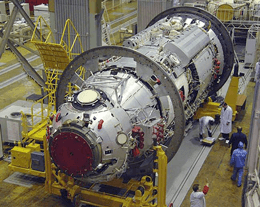
The Russian Nauka module was launched on July 21, 2021 after many years of delays. Because it was to be placed on the ISS on the port that was occupied by the Pirs Docking Compartment, the Pirs module had to be removed before Nauka could launch. Pirs was removed on July 23, 2021 and disintegrated in Earth's atomosphere over the South Pacific after 20 years of service. Using the CanadArm to inspect the port, it was determined that no additional measures were needed to dock the new module.

After a successful launch on a Proton-M rocket, the Nauka module had some engine problems causing many propulsive manuevers, using up more fuel than expected. It was able to dock safely with the station, using up most of its remaining fuel. The problems may have been caused by software issues.
Problems with Nauka docking did not stop there. Thrusters on the module began to fire and spin the ISS by 1/2 a degree per second. Before the engines could be stopped, the ISS rotated one and a half times or 540 degrees. This motion was stopped and corrected by firing thrusters on the Zvezda service module and the Progress MS-17 vehicle. Although communication with the station was lost twice for several minutes each time, the crew onboard was not in danger.
The Nauka module was first constructed as a backup to the Zarya module currently on ISS. The design used for Nauka and Zarya is called the Functional Cargo Block (FCB). The FCB was designed as a service and storage module. It featured a spacious pressurized volume in its center, meant for cargo storage and docking equipment. On the outside of the FCB were fuel tanks, maneuvering engines, solar arrays, and docking port.
The Nauka contains water and air purification systems, a new galley, and a toilet. Nauka is Russian for "Science" and after it was fitted to the ISS, Nauka became the primary laboratory module on the Russian segment. It is also known as the Multipurpose Laboratory Module (MLM). Nauka is attached to ISS at Zvezda nadir, an Earth-facing docking. Because of this position, the ISS was rotated to allow the module to dock.
Unfortunately, these problems set back the launch of the Boeing Starliner human crew spacecraft final uncrewed demnostration mission. Because other issues also arose, the launch is now scheduled TBD.
Roscosmos Media released a video showing the Nauka module dock being opened by cosmonauts on ISS. Find it here on youTube.
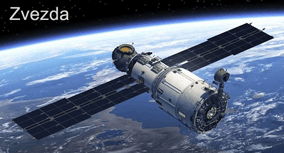
Pirs was launched in 2001. It served as a docking port for Soyuz and Progress spacecraft. It had two airlocks for astronauts to enter and exit the ISS for EVA's or spacewalks. Before Nauka was attached to the ISS the PIRS module had to be removed. Progress space craft carried cargo to the ISS and attach to the PIRS. The PIRS module was be unlatched from Zvezda and both the Progress and PIRS eased away from the station powered by the Progress vehicle. The Progress deorbiedt with Pirs and made a destructive reentry into Earth’s atmosphere. Pirs was the first module of the Station to be permanently removed.
Roscosmos plans to build a new space station in Earth orbit called the Russian Orbital Station, or ROS. Like the commercial station discussed below, The ROS will eventually splinter away from the current International Space Station that will eventually be retired. (That date is 2030 today.) It is planned that the Nauka module will be the heart of the new station.
Russian Prichal ISS Module

On November 24, 2021, Roscosmos launched the Prichal module that was connected to the ISS a few days later. Prichal or "Uzlovoi Modul"(UM) or Node Module in English. Prichal is a component that can allow up to six other modules to connect to the new station. Other modules to be attached could be crew ships, cargo haulers, tankers, or other structural elements. This module may also be used as the permanent core of the future ROS station. In that case, all other modules could be added or removed as they age or due to mission updates.
The module is connected to the nadir or Earth-facing section of the ISS. It should provide docking for up to 5 vehicles at the same time.
Commercialization and Utilization
NASA took a major step announcing the low Earth orbit commercialization initiative, the Next Space Technologies for Exploration Partnerships (NextSTEP) program. NASA has a long-term goal to aid commercial development in space. The commercial effort intends to add astronaut training, scientific research, and technology demonstrations in low Earth orbit to the International Space Station.
Axiom Space won a NextSTEP, a five-year base performance period and a two-year option contract to deliver a nodule to the space station. Although NASA funding has been sporadic, Axiom is building the first module with its own resources. The first astronauts to live in the Axiom station will pay for their space tour. Currently the price tag is $55 million US! This image was provided by Axiom Space to illustrate the commercial space station they invision.
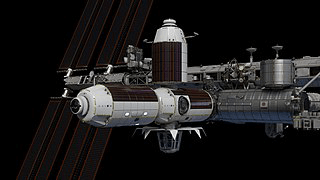
Thales Alenia Space will provide two key pressurized elements for the Axiom Commercial Space Station. Axiom will be attached to the docking port on the ISS Harmony module. Axiom is intended to be a comfortable work place, as well as a tourist destination as soon as it can establish itself. The first two Axiom station elements to fly are Axiom Node One (AxN1) and Habitation Module (AxH). Once Axiom grows large enough and can power itself, it can spin off into a new orbit.
Space Station Elements
AxH1 is the first Axiom station module with living quarters for 4 crew members and space for research and manufacturing. AxH1 is also called Axiom Hab One. It will be the nucleus for human activity in Earth orbit. Each personal crew quarter is equipped with an Earth-viewing window and touch-screen communications panel. A docking adapter will allow visiting vehicles to dock to the Axiom Station. The module also includes 4 ports where additional future modules can be attached. Currently a launch date of 2025 is proposed.
AxH2 is the second node that Axiom hopes to launch. It adds four additional crew quarters and will bring the crew capacity of the Axiom Station to eight. It will give the Axiom station more microgravity research space and add eight new ports to dock visiting vehicles or future station modules. Currently a launch date of 2025 is proposed.
AxL, the third module planned for the Axiom station will be built from an ISS module once flown as the Multi-Purpose Logistics Module that was previously used to carry cargo to the station. It will be newly outfitted as a Axiom Laboratory module. This module will support research and manufacturing. The Lab will provide more space for industrial research and manufacturing that will be managed by astronauts on the Axiom Station. Currently a launch date of 2026 is proposed.
AxPT2027 is the last module, a solar power platform that provide the commercial modules power and cooling to allow separation with the ISS. It is also called the Axiom Power Tower. It will be attached to the zenith port of the Hub, with a solar array that can produce as much power as the current ISS solar arrays. It will expand the Axiom Station's environmental control and life support (ECLSS) capabilities, add additional storage, and provide an airlock for EVAs or spacewalks. Currently a launch date of 2027 is proposed.
Axiom Commercial Space Station
Axiom Mission 1 (Ax-1)
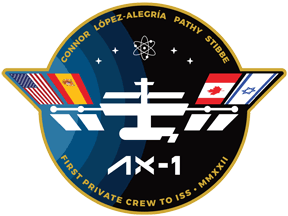
The first Axiom Space mission (Ax-1) launched on a Falcon 9 block 5 launch vehicle from Kennedy Space Center's Launch Complex 39A. The mission flew aboard Crew Dragon Endeavour. Launched on April 8, 2022 the crew lived aboard the U.S. segment of the ISS, participating in various research investigations in the microgravity environment.
- Ax-1 Crew -
Michael López-Alegría named mission commander is a veteran astronaut. Larry Connor is 71 and president of the Connor Group. He became the second-oldest astronaut to go to space after John Glenn, who flew to space at 77 years old. Mark Pathy is a Canadian. Mission Specialist Eytan Stibbe of Israel is a former Israeli fighter pilot. The first private astronaut crew was launched on April 8, 2022 and returned on April 25.

Axiom Mission 2 (Ax-2)

Axiom sent 4 crew members for 10-day mission, on the ISS. They spent 8 days working and living on the orbiting laboratory while carrying out science, outreach, and commercial activities. The mission was launched on May 21, 2023 on a SpaceX Falcon 9. The Axiom-2 crew returned to Earth on May 31, 2023. The crew rode to and from the International Space Station on the Crew Dragon, Freedom, spacecraft.
- Ax-2 Crew -
The crew included former NASA Astronaut Peggy Whitson as mission commander and John Shoffner as pilot. Saudi Arabia's Saudi Space Commission (SSC) paid to send the first Saudi astronauts, Ali AlQarni and Rayyanah Barnawi as mission specialists. Ali is a captain in the Royal Saudi Air Force and Rayyanah is a biomedical researcher who has conducted stem cell research. The crew conducted genetic research on the ISS.

Axiom Mission 3 (Ax-3)
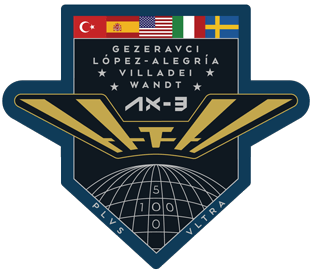
Axiom sent four crew members to the ISS on the Ax-3 mission that lasted four extra days because of poor weather at the landing area. The crew spent 18 days working and living on the orbiting laboratory, conducting over 30 different experiments and over 50 outreach activities. The mission was launched on January 18, 2024 on a SpaceX Falcon 9. The Axiom-3 crew returned to Earth on February 9, 2024. The crew rode to and from the International Space Station on the Crew Dragon, Freedom, spacecraft.
- Ax-3 Crew -
The crew included returning commander Michael López-Alegría of the U.S. and Spain. Walter Villadei of the Italian Air Force as pilot. Alper Gezeravcı of Türkiye and Marcus Wandt of Sweden and the European Space Agency (ESA) as mission specialists.
Axiom Mission 4 (Ax-4)
Axiom Space plans to launch its fourth mission, Axiom Mission 4, to the ISS on June 8, 2025 at 9:11 am from NASA’s Kennedy Space Center in Florida. The citizen astronauts will spend 14 days on the space station. On this mission, four different nations will be represented U.S.A, India, Poland, and Hungary. During the mission, astronauts will perform 60 scientific studies and activities. These studies will cover human research, Earth observation, life and biological sciences, and material sciences.

- Ax-4 Crew -
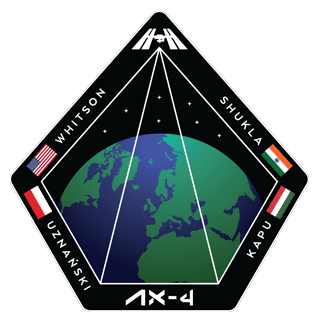
The crew includes Peggy Whitson a former NASA astronaut and returning Axiom commander. Shubhanshu Shukla from Indian Space Research Organisation as pilot. Sławosz Uznański of the European Space Agency (ESA) and Tibor Kapu of Hungary as mission specialists.
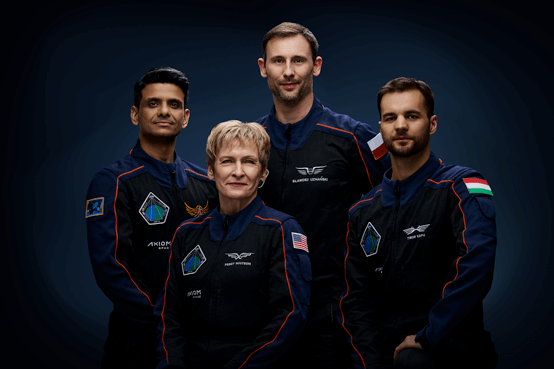
Links to off-site web pages
Visit Axiom Space website
See The ISS from your own backyard !
NASA's Space Station Main Page - at Nosegays
International Partners
The international partnership of space agencies working together on the space station includes the space agencies of the United States, Russia, Europe, Japan, and Canada. This very complex project illustrates how possible it is for nations and people to work together, unifying the planet and our ventures into the new frontier.
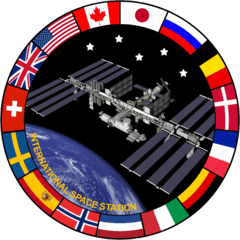
International Space Station Education
A few of the highly successful educational programs that were executed and hopefully many more space exploration and science programs will continue to excite the youth of the U.S.A. and other countries to move into STEM or STEAM fields.
ISS National Laboratory Stem Education Programs
STEM on Station: Get Involved With Station
Space Station Research For Educators - NASA
Student Spaceflight Experiments Program (SSEP) National Center for Earth and Space Science Education (NCESSE) in partnership with Nanoracks, LLC.
ISS National Laboratory Stem Education Programs
Lesson: Life in Space: The International Space Station - Teach Engineering
- - For more educational links at Astra's Astronomy and Space Education Page
